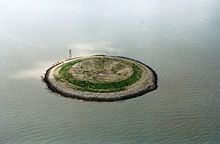Outer Trial Bank facts for kids
Quick facts for kids Outer Trial Bank |
|
|---|---|
 |
|
| Type | Nature reserve |
| Location | The Wash, East Anglia, England |
| Area | 4.265 hectares (10.54 acres) |
The Outer Trial Bank is a special round island built by people in a place called the Wash. The Wash is a large bay on the east coast of England. This island is one of two islands made in the 1970s. They were built for a government plan about water.
Contents
A Look Back: Why Was the Island Built?
In 1972, the government of Britain started a big study. They wanted to see if they could build a huge wall, called a tidal barrage, across half of the Wash. The main idea was to collect fresh water from several rivers. These rivers included the River Witham, River Welland, River Nene, and Great Ouse. This fresh water would then be stored in a giant reservoir.
Building the Test Islands
As part of this test, they got permission to build an artificial island. This island was about 2 miles (3.2 km) away from the coast of Lincolnshire. Work on it began in February 1975. People often called this island "the doughnut" because it was shaped like one. It was made from sand and protected by strong limestone rocks. The island was 250 metres (820 ft) wide. In its center, it had a small pool of water about 1 hectare (2.5 acres) in size.
Before building the big island, a smaller, simpler test bank was made. It is connected by a raised path, called a causeway, on Terrington Marsh in Norfolk.
What They Learned from the Test
The study finished in 1976. It showed that building the test island alone was too expensive. It cost about £3 million. Also, the fresh water was too close to the salty sea water. This meant the water was too salty and had too much dirt (silt) in it. Because of these problems, the test was stopped. The plans for the big water scheme were put away.
What the Island is Used for Today
Even though the original plan didn't work out, the Outer Trial Bank is very important now. It is a special place where seabirds build their nests. It is part of the national nature reserve of the Wash. In 2008, about 3,000 pairs of birds made their homes on the island.

